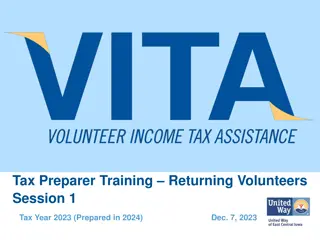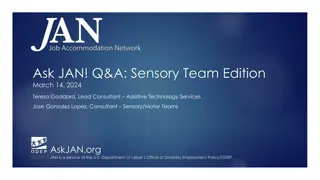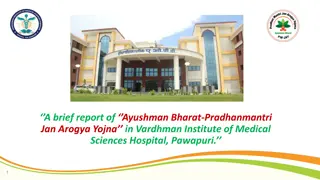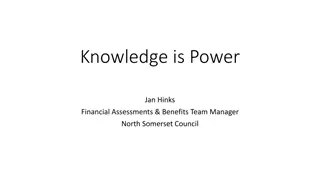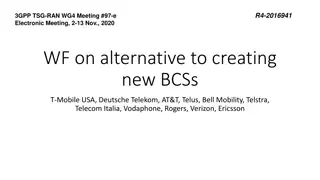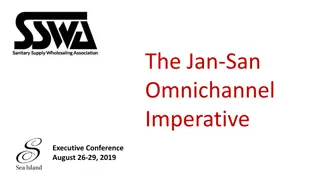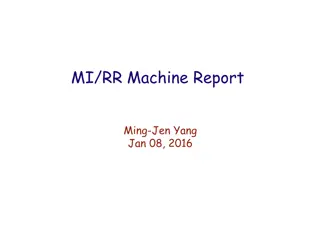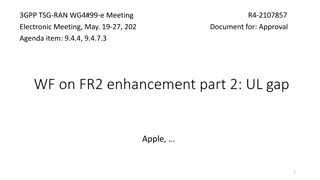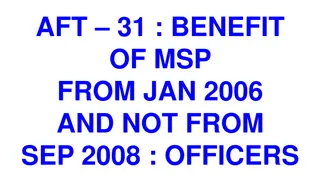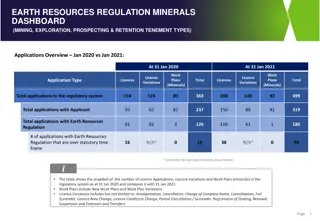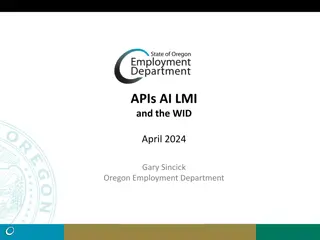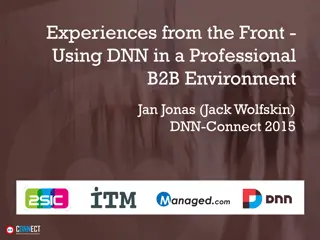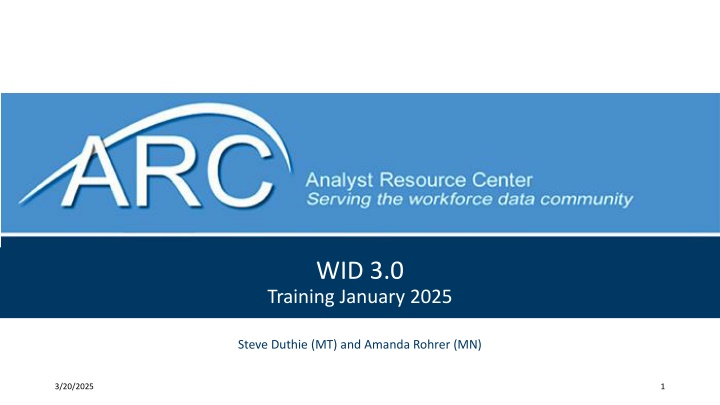
Evolution of WID Database Structure
Explore the history and significance of the Workforce Information Database (WID), from its inception in 1996 to the latest version 3.0 in 2025. Learn about major changes, challenges, and motivations driving the evolution of this vital database for job seekers, employers, and planners.
Download Presentation

Please find below an Image/Link to download the presentation.
The content on the website is provided AS IS for your information and personal use only. It may not be sold, licensed, or shared on other websites without obtaining consent from the author. If you encounter any issues during the download, it is possible that the publisher has removed the file from their server.
You are allowed to download the files provided on this website for personal or commercial use, subject to the condition that they are used lawfully. All files are the property of their respective owners.
The content on the website is provided AS IS for your information and personal use only. It may not be sold, licensed, or shared on other websites without obtaining consent from the author.
E N D
Presentation Transcript
WID 3.0 Training January 2025 Steve Duthie (MT) and Amanda Rohrer (MN) 3/20/2025 1
History, Why a WID? In The Beginning There Was Chaos! There were just too many variations of the data being provided 3/20/2025 2
History, Why a WID? A Joint effort between the Employment and Training Administration of the U.S. Department of Labor and the States to: - conduct research, - develop products, and - deliver Information to job seekers, employers, economic developers, planners and other users. Started on the database structure in August 1996 using 2 existing databases OLMID North Carolina s Human Resource Information System Database. The structure needed to be database agnostic America s Labor Market and Information Database (ALMIS) Workforce Information Database (WID) The WID Database is a Normalized, Relational Database Structure 3/20/2025 Optional Tagline Goes Here | mn.gov/websiteurl 3
History, Why a WID? The final structure design for table layout for the WID Database includes: Lookup tables Data tables Crosswalk tables Tables of standard field values Administrative tables These tables contain data for Employment, Unemployment, Income, Population, Current Employment Statistics, Occupation and Industry codes and much more The Employment and Training Administration of the U.S. Department of Labor Provides Funding Analyst Resource Center (ARC) consists of members from the states to continue with updating the WID structure and provide for education and training on the WID. 3/20/2025 4
Major Changes and What Motivated Them One of the charges for the ARC is to update and suggest changes for the WID structure for both Major and Minor changes. Minor changes or a dot release versions such as 2.8 are items that don t change underlying structure of the database. Major changes are prime version changes and affect at least a majority if not all tables in the structure. Changes have covered software restrictions, new data availability and/or priorities, state suggestions, data deprecation, in essence BLOAT. Legacy Issues: Over 20 years of structure changes. Maintenance Challenges: Artifacts increasing error risks. Deprecation Complexity: The implementation of deprecation caused confusion. Opportunity for Housekeeping: WID 3.0 provides a chance to clean up. 3/20/2025 Optional Tagline Goes Here | mn.gov/websiteurl 5
Major Changes and What Motivated Them The First Major Change was version 1.1 to 2.0 Version 1.0 was release in 1997 by 2002 version 2.0 was released. Changes From 1.1 to 2.0 Number of Tables Added: 36 Number of Tables Changed: 42 Number of Tables Deleted: 11 Number of Tables Unchanged: 72 In 2025 the second major release 2.8 to 3.0 Changes From 2.8 to 3.0 Total Number of Tables 220 (ver. 2.8) 121 (ver. 3.0) Number of Tables Added: 10 Number of Tables Changed: 117 Number of Tables Deleted: 109 Number of Tables Unchanged: 4 (21) 3/20/2025 6
Major Changes and What Motivated Them Modernization Technology Over Structure: Recent committee efforts have emphasized leveraging modern technology. Field Name Usability: Cryptic field names, human-readable field names improves future development and onboarding. AreaTypeVersion Solution: Consistency Across States: Frequent changes to MSA (Metropolitan Statistical Area) definitions. API Compatibility: Inconsistent MSA implementation complicates cross-state data API calls. GeneralCleanup (Housekeeping) User-Friendly Field Names: Simplified field names help onboard new hires and reduce training time. Descriptive Content: Expanded title and description fields prevent issues when loading descriptive content. Projection Table Consistency: Previously inconsistent projection methods are now aligned with other tables, enhancing clarity. 3/20/2025 7
Requirements State Requirements vs. WIGS Requirements What is a Core Table? What Data Do You Need to Maintain? Where Do You Get It? 3/20/2025 8
Requirements State Requirements vs. WIGS Requirements Per the TEGL, the WID should be populated and maintained for consistent and reliable data across jurisdictions. Published data should be stored in WID format where it s defined for a subject, but only Core Tables are required. 3/20/2025 9
Requirements What is a Core Table? Core tables include BLS programs data, Occupational Licenses, and the Employer Database content. To support these tables there are a number of lookup tables that contain industry titles, occupational titles, geographic descriptions, and other labels and descriptive content. Many of those are static and require no maintenance. SOC Codes and Geographies can be more cumbersome. 3/20/2025 10
Requirements State Requirements vs. WIGS Requirements WID standard has been around a long time and many other requirements have been built off it. State Dependencies: - User applications for data analysis, such as R, SAS, or Tableau - Internal or external applications for publishing data - Relationships with contractors, such as Geographic Solutions or LMIInformer - Reports or inputs to other programs (e.g. QCEW employment for NCE calculation for LAUS/CES) - Non-standard content Changes to the standard has implications for these dependencies 3/20/2025 11
Requirements What data do you need to maintain? The WID should generally include any data that the state regularly publishes. There is no obligation to include other state data, historical data going back further than state policy requires, or detail beyond required publication standards. Consider: - Regional detail - Suppressions - Industry or occupational detail In some tables, there are fields that offer additional detail, such as latitude and longitude, that may not be something states publish. It is fine to leave them null if they allow nulls. 3/20/2025 12
Requirements Where do you get the data? BLS programs have WID output for state data. OEWS is available in WID format from LEWIS. Projections data is available in WID format from Projections Suite. Employer Database data comes from the vendor in WID format. License data is created by states and should be formatted appropriately. Publicly available national data may be downloaded from the Widcenter.org website or obtained directly from federal sources. 3/20/2025 13
Navigating the Website Core Tables Content Index and Documentation Downloadable content Support 3/20/2025 14
Navigating the Website Understanding the Structure Document Document is grouped by Table Type Core tables are marked with an apple core in both the index and the table definition Don t skip the Appendices! - Core tables list - Summary of changes - Appendix D WID 2.8 Name and Associated Program 3/20/2025 15
Navigating the Website Core tables list and links WID 3.0 https://widcenter.org/document/wid-3-0-core-tables/ WID 2.8 https://widcenter.org/document/all-core-tables/ 3/20/2025 16
Navigating the Website Content Index and Documentation Provides links to source data Provides links to files in WID format, where available Provides description of limitations and challenges of working with the data source, including release frequency and changes Primarily Core tables, but also includes some landing pages for topics on which we get frequent questions 3/20/2025 17
Available Resources for Migration ULMITA.org LEWIS/Projections Forum Suggested Implementation Procedure - Overview of approach and considerations - Current structure document - Scripts to create the WID structure - Scripts to create Compatibility views (aliasing core tables to their previous field names) - Scripts to create Application views (brings titles into core tables for convenience) - Migration script to move data from a clean version of WID 2.8 to WID 3.0 (will likely require customization) Some notes on customization: Some states add additional detail to their lookup tables. Occupational licenses for example has very broad categories and for states with well-developed programs, they may have access to much more refined categories. For the most part this is good, provided the lookup table properly reflects those relationships and can be used to get the appropriate descriptive content. Wherever possible use the standard values and use custom values that fall within the range allocated to them (50-70). 3/20/2025 18
Available Resources for Migration Pitfalls Lookup tables: The required contents of lookup tables depend on what data is being stored. A long time series (particularly in the Industry table) or state customization (e.g. additional detail in Licenses lookups) is likely supported by state-specific content in the lookup tables Structure customization: States have modified structures in minor ways to accommodate their data, for example expanding the size of title fields or adding extra fields at the end of a table. Those inconsistencies may cause errors in migration that will need to be corrected Unsupported software: MS Access is used by a lot of states either to meet the WID requirement or for local storage/processing before uploading data to a vendor. Access has limitations on key structure that doesn t work for the WID. 3/20/2025 19
Questions? What additional resources would help you? What concerns about the process do you have? 3/20/2025 20

